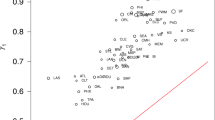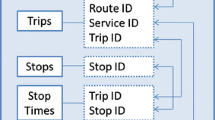Abstract
This article documents the development of a direct travel demand model for bus and rail modes. In the model, the number of interzonal work trips is dependent on travel times and travel costs on each available mode, size and socioeconomic characteristics of the labor force, and the number of jobs.
In estimating the models’ coefficients constraints are imposed to insure that the travel demand elasticities behave according to the economic theory of consumer behavior.
The direct access time elasticities for both transit modes are estimated to be approximately minus two, and the direct linehaul time elasticities approximately minus one. The cross-elasticities with respect to the travel time components are estimated to be less than the corresponding direct elasticities. In general, the time cross-elasticities are such that rail trip characteristics but not car trip characteristics affect bus travel, and car trip characteristics but not bus trip characteristics affect rail travel. The cost elasticities lie between zero and one-half.
Thus, the success of mass transit serving a strong downtown appears to depend on good access arrangements. This success can be confirmed with competitive linehaul speeds. The cost of travel appears to assume a minor role in choice of mode and tripmaking decisions.
In the paper, a comparison is also made between the predictive performance of the models developed and that of a traditional transit model. The results indicate that the econometric models developed attain both lower percent error and lower variation of the error than the traditional model.
Similar content being viewed by others
References
An Evaluation of Free Transit Service (1968). Cambridge: Charles River Associates, Inc. Domencich, T. A. et al. 1968. Estimation of Urban Passenger Travel Behavior;an Economic Demand Model. A paper presented at the Annual Meeting of Highway Research Board, January.
Kraft, G. and Wohl, M. (1967). “New Directions for Passenger Demand Analysis and Forecasting,”Transportation Research I: 3.
Lancaster, K. J. (1966). “A New Approach to Consumer Theory,”Journal of Political Economy LXXXIV: 132–157.
Meyer, J. and Glauber, R. (1963). Investment Decisions, Economic Forecasting and Public Policy. Boston, Mass.: Harvard Business School.
Model of Urban Passenger Travel Demand in the San Francisco Metropolitan Area (1967). Cambridge: Charles River Associates.
Morlok, E. K. (1970). “A Goal Directed Transportation Planning Model,”Transportation Research 4: 199–213.
Oi, W. and Shuldiner, P. (1962).An Analysis of Urban Traffic Demand. Evanston, Illinois: Northwestern University Press.
Talvitie, A. P. (1971).An Econometric Model for Downtown Work Trips. Ph.D. dissertation. Evanston, Illinois: Dept. of Civil Engineering, Northwestern University.
Theil, H. (1966).Applied Economic Forecasting. Amsterdam: North Holland Publishing Company.
Walker, S.-(1971).Five Trip End Transit Model. M.S. thesis, Evanston, Illinois: Dept. of Civil Engineering, Northwestern University.
Wold, H. and Jureen, L. (1953).Demand Analysis: A Study in Econometrics. Stockholm: Almquist and Wicksell.
Author information
Authors and Affiliations
Rights and permissions
About this article
Cite this article
Talvitie, A. A direct demand model for downtown work trips. Transportation 2, 121–152 (1973). https://doi.org/10.1007/BF02428556
Issue Date:
DOI: https://doi.org/10.1007/BF02428556




